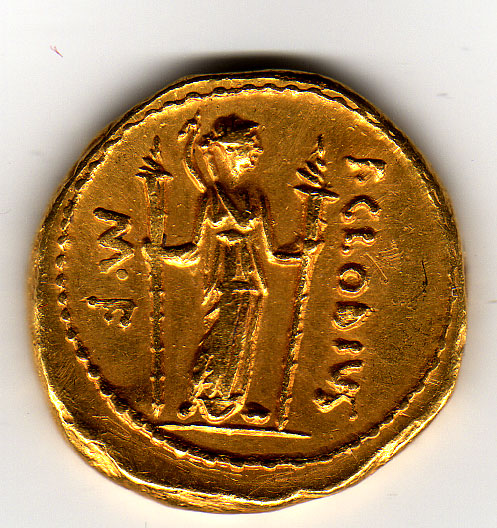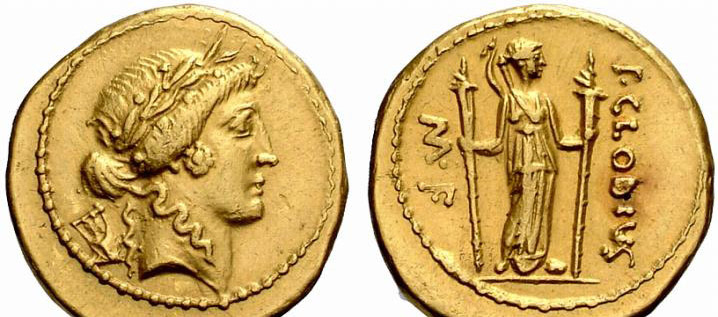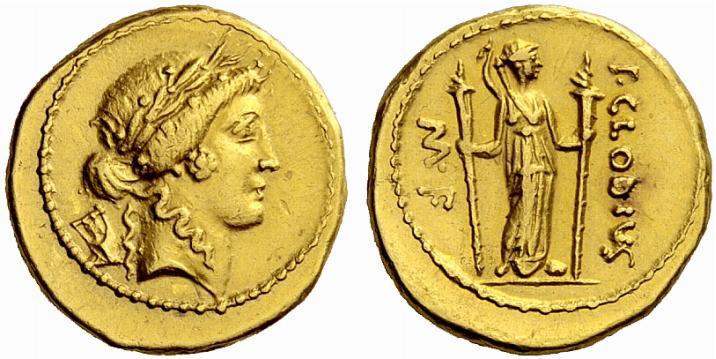

OBJETS ROMAINS ...
AUREUS de Publius Clodius Turinus (42 avant JC), 7.96gr / 3h SUP/FDC, Tête d'Apolon à droite, identique au denier.
Pour ma part je considère ces trois monnaies connues comme issues du même coin, et en gravure d'essai, ce qui justifie la similitude des auréus. D'autre part j'ai eu en main cet auréus bien avant les ventes publiques, et celles-ci ne présentaient qu'une photo tronquée de la monnaie, alors que j'ai toujours publié la photo complète.
d=20 mm
P. Clodius. Aureus circa 42 BC, 7.96 g. Laureate head of Apollo r.; in field l., lyre. Rev. P·CLODIVS – M·F Diana standing facing, with bow and quiver over shoulder, holding lighted torch in each hand. Crawford 494/22. Syd. 1116. B. Clodia 14. . Sear Imperators 183.
Of the highest rarity, only three specimens known and the only one in private hands and in FDC (without holes like on the second specimen on the right of letter D of Clodius, complete grenetis and hight relief).
extremely fine / FDC
The four moneyers of 42 B.C. struck aurei and denarii with portraits of Antony, Octavian and Lepidus, and non-portrait coins bearing types of personal value. P. Clodius was especially productive in that he supplemented his portrait aurei of the triumvirs with portrait denarii for Antony, Octavian and the deified Julius Caesar and non-portrait issues.
His two non-portrait types occur as both aurei and denarii and bear designs of a personal nature relating to the cults of Sol and Luna. This aureus pairs Apollo with Luna Lucifera, and his other non-portrait issue pairs the head of Sol with a crescent moon and stars. Since Apollo was considered a god of pure light and the bringer of daylight, his solar aspects are here paired with the goddess Luna in her guise as the light-bringer (lucifera).
Origine : Cette monnaie provient d'un archéologue Français ayant séjourné assez longuement à la Villa Médicis à Rome, dans la première moitié du 20ème siècle. Elle est en ma possession depuis plus de 7 ans, et ma été vendue par l'amie de cet archéologue. J'ai publié cet auréus depuis plusieurs années en pensant qu'il était unique, et c'est seulement très récemment que j'ai appris l'existence de deux autres. Le second s'est vendu le 26 octobre 2005 par Numismatica Ars Classica en Suisse. J'avais moi-même envoyé depuis plusieurs années sa photo à Eukratides Ancient Numismatics VCOINS dirigé par Dr. Brad Bowlin, qui voulait représenter mes monnaies dans sa boutique bien avant que je n'ouvre une boutique sur Ebay. Le premier specimen connu se trouve dans un Musée à Vienne en Autriche, malheureusement je n'ai pas la photo, mais on peut voir cette photo dans le Bahrfedlt, les monnaies d'or romaines pl V,7.
Origin: This currency comes from a French archaeologist having remained rather lengthily to the Médicis Villa in Rome, in first half of the 20th century. It has been in my possession for more than 7 years, and my summer sold by the friend of this archaeologist. I have published this aureus for several years by thinking that it was single, and it's only very recently that I learned the existence from two others. The second was sold on October 26, 2005 by Numismatica Ars Classica in Switzerland. I had sent myself for several years his photograph to Eukratides Ancient Numismatics VCOINS directed by Dr. Brad Bowlin, which wanted to represent my coins in its shop well before I do not open a shop on Ebay.The other specimen known is in a museum in Wien. Unfortunately, I do not have a picture of this specimen, but you can see an image of the coin in the Bahrfedlt, Die Romisch Gold munzen pragung, pl. V, 7.
Les doutes quant à l'authenticité de cette pièce ont été définitivement dissipé grâce à l'analyse du métal faite par le professeur Claudio Botrè de l'Université de Rome "La Sapienza", et publié avec E. Fabrizi, C. Scibona, P. Serafin Petrillo , dans l'article le plus exhaustif et intéressant: Applicazioni della spettroscopia con Fluorescenza un Raggi X nello studio di Antiche Monete romane: implicazioni di carattere storico ed economico. Pour être honnête, nous devons souligner que nous ne considérons pas l'analyse des métaux comme le test ultime de prouver l'authenticité d'une pièce de monnaie, que les plus récents faussaires utilisent pour leur production la fonte des pièces anciennes pour produire des contrefaçons. Le cas de cette très rare pièce de monnaie ici proposée est différent, comme ce spécimen est apparu sur le marché numismatique il ya plus de cinquante ans, lorsque les techniques de production et de contrefaçons n'étaient pas sophistiqués et ne prenaient pas en considération la possibilité d'utiliser du métal antique. Comme preuve supplémentaire, la pièce a été présentée au Musée de Vienne, où un autre exemplaire connu est conservé, à titre de comparaison et une fois de plus l'authenticité a été confirmée.
The doubts regarding the authenticity of this coin have been definitively dispelled thanks to the analysis of the metal made by Professor Claudio Botrè of the University of Rome "La Sapienza", and published along with E. Fabrizi, C. Scibona, P. Serafin Petrillo, in the most exhaustive and interesting article: Applicazioni della spettroscopia con fluorescenza a raggi X nello studio di antiche monete romane: implicazioni di carattere storico ed economico. To be honest, we have to stress that we do not consider the metal analysis to be the ultimate test to prove the authenticity of a coin, as the most recent forgers use for their production melted down ancient coins to produce fakes. The case of this exceedingly rare coin here offered is different, as this specimen appeared on the numismatic market more than fifty years ago, when the production techniques of production of fakes were not sophisticated and were not taking into consideration the possibility of using ancient metal. As further evidence, the coin has been submitted to the Museum of Vienna, where the other known specimen is kept, for comparison and once again the authenticity has been confirmed.


Photo du Second exemplaire connu , Photo of the second known specimen :

Publius Clodius Turinus est de la grande famille des Claudia. Nous rappelons que la dynastie des Julio-Claudia a donné cinq empereurs mis à part Jules César ( Octave-Auguste, Tibère, Caligula, Claude et Néron). Rhèteur et orateur, il est l'ami de Sénèque et de Jules César, de Ciceron et de Pline. Après la mort de Jules César en 44 avant notre ère (le 15 mars aux Ides de Mars, percé de vingt et un coups de stylet et tombe mort devant la statue de Pompée. Ses assassins, dont Brutus et Cassius, sont obligés de quitter Rome à l'instigation d'Antoine, tandis qu'Octave accourt d'Illyrie pour recueillir l'héritage de son grand-oncle. Antoine, Consul, fait donner de grandes funérailles à César et empêche l'abrogation de ses actes . ) , il émet des deniers et des auréus à son nom, dès 42 avant notre ère, en tant que représentant d'une des grandes familles, tout comme le feront d'autres grandes familles dans cette période troublée, manière de consolider la république en péril. En 42 on était sous le consulat de Marcus Aemilius Lepidus. Octave et Marc Antoine renversent Brutus et Crassus (les assassins de César et le coeur de la faction pro-républicaine à la bataille de Philippi). Cassius et Brutus se suicident. Cette bataille met fin à la première phase de la guerre civile qui va durer encore douze ans .
Sous le consulat de Marcus Lépidus et de Quintus Catulus, il s'éleva une guerre civile, qui fut éteinte presque avant d'éclater. Mais si courte que fût sa durée elle ne s'en alluma pas moins au bûcher même de Sylla. Avide de nouveautés, Lépidus eut la présomption de vouloir abolir les actes d'un si grand personnage. Il n'aurait pas eu tort, s'il avait pu le faire sans grand dommage pour la république. Le droit de la guerre avait permis à Sylla, alors dictateur, de proscrire ses ennemis. En rappelant ceux qui survivaient, Lépidus ne les appelait-il pas aux armes ? Sylla avait vendu aux enchères les biens des citoyens condamnés ; cette vente, si injuste fût-elle, était légale. Les restituer, c'était sans aucun doute ébranler l'État enfin rendu à la paix. Malade et blessée, la république avait avant tout besoin de repos et, en voulant soigner ses blessures, on risquait de les rouvrir.
Après que les harangues séditieuses de Lépidus eurent jeté dans la ville la même terreur que la trompette guerrière, Lépidus partit en Étrurie et y leva une armée qu'il fit marcher sur Rome. Mais déjà le pont Milvius et le Janicule avaient été occupés par une autre armée que commandaient Lutatius Catulus et Cnéus Pompée, chefs et porte-drapeaux du parti de Sylla. Ils le repoussèrent dès le premier choc, et le sénat le déclara ennemi public. Lépidus s'enfuit sans verser de sang et se retira en Étrurie, puis en Sardaigne, où il mourut de maladie et de regret. De leur côté, les vainqueurs, donnant un exemple rare dans les guerres civiles, se contentèrent d'avoir rétabli la paix.
Sur le revers de ses deniers et auréus on retrouve P. CLODIVS M. F. Diana Lucifera debout de face, tournée à droite, tenant dans chaque main, un grand flambeau allumé.
Le culte de Diane a été introduit à Rome par les Sabins. Le revers de ce denier pourrait rappeler les origines de la gens Claudia mais aussi se rapporter à la déification de César ou aux Ludi Apollinares qui se tenaient du 6 au 13 juillet de chaque année. César était né le 13 juillet 100 avant J.-C. Ce denier sera restitué par Trajan et existe aussi en aureus (Syd.1116) taillé au 1/40 L. (8,118 g.) .
Au culte de Diane était associé celui de Sol. Il existe une association entre Sol et Apollon, voir en particulier sous Constantin avec Soli Invicto Comiti et la visite de Constantin au temple d'Apollon Granus (medicus) à Grand dans les Vosges. Marc-Antoine fut le "grand-prêtre" du nouveau culte associant Sol au divin Jules. Après la mort du dictateur, une étoile filante (comète) avait traversé les cieux. les romains superstitieux considérèrent que c'était l'esprit de César qui fut divinisé (sideis Iulis) en 42 avant J.-C .
Publius Clodius Turinus is great family of Claudia. We point out that
the dynasty of Julio-Claudia gave five emperors put aside Jules César
(Octave-Auguste, Tibère, Caligula, Claude and Néron). Rhetor and
speaker, he is the friend of Sénèque and Jules César, Ciceron and
Pline. After the death of Jules César in 44 before our era (on March
15 in ides of march, bored of twenty and one blows of stylet and fall
dead in front of the statue from Pumped. Its assassins, whose Brutus
and Cassius, are obliged to leave Rome at the instigation of Antoine,
while Octave runs of Illyrie to collect the heritage of its
great-uncle. Antoine, Consul, make give great funeral to César and
prevent the abrogation of his acts. ), it emits sums of money and
auréus with its name, as of 42 before our era, as a representative of
one of large family, just like will do it other great families
during this disturbed time, manner of consolidating the republic in
danger. In 42 one was under the consulate of Marcus Aemilius Lepidus.
Octave and Marc Antoine reverse Brutus and Crassus (assassins of
César and the heart of the pro-republican faction to the battle of
Philippi). Cassius and Brutus commit suicide. This battle puts an end
to the first phase of the civil war which will last twelve more years.
Under the consulate of Marcus Lépidus and Quintus Catulus, it rose a civil war, which was extinct almost before bursting. But so short that it was its duration did not light any less with roughing-hew even of Sylla. Avid of innovations, Lépidus had the presumption to want to abolish the acts of a so large character. It would not have been wrong, if it had been able to do it without much damage for the republic. The right of the war had allowed Sylla, then dictator, to proscribe his enemies. By pointing out those which survived, didn't Lépidus call them with the weapons? Sylla had sold with the biddings the goods condemned citizens; this sale, if unjust was it, was legal. To restore, it was without any doubt to shake the State finally returned to peace. Patient and wounded, the republic had before any need for rest and, by wanting to look after his wounds, one risked of the rouvrir.Après that the seditious harangues of Lépidus had thrown in the city same terror that the warlike trumpet, Lépidus left in Étrurie and raised there an army which it made go on Rome. But already the Milvius bridge and Janicule had been occupied by another army which Lutatius Catulus and Cnéus Pompée, chiefs and flag-holders of the party of Sylla ordered. They pushed back it as of the first shock, and the senate declared it public enemy. Lépidus flees without pouring blood and was withdrawn in Étrurie, then in Sardinia, where he died of disease and regret. On their side, the winners, giving a rare example in the civil wars, were satisfied to have restored peace.
On the reverse of his sums of money and auréus one finds upright P. CLODIVS Mr. F Diana Lucifera of face, round on the right, holding in each hand, a large torch allumé.Le worship of Diane was introduced in Rome by Sabins. The reverse of this sum of money could point out the origins of Claudia people but be also referred to the deification of César or Ludi Apollinares which were held from the 6 to July 13 of each year. César had been born on July 13 100 before J.-C. This sum of money will be restored by Trajan and also exists in aureus (Syd.1116) cut to the 1/40 L. (8,118 G.) . With the worship of Diane was associated that with Ground. There is an association between Sol and Apollo, to see in particular under Constantin with Soli Invicto Comiti and the visit of Constantin to the temple of Apollo Granus (medicus) in Grand in the Vosges. Marc-Antoine was the "high priest" of the new worship associating Sol to the divine Jules. After the death of the dictator, a shooting star (comet) had crossed the skies the superstitious Romans considered that it was the spirit of César which was deified (sideis Iulis) in 42 before J.-C.

NAC (NUMISMATICA ARS CLASSICA) Auction 51 du 5 mars 2009, remise en vente du second exemplaire connu:
http://www.acsearch.info/record.html?id=25841
Auction 51 Part I
The Roman Republic
P. Clodius M. f Turrinus. Aureus 42, AV 8.14 g. Laureate head of Apollo r.; in l. field, lyre. Rev. P·CLODIVS – M·F Diana standing facing, with bow and quiver over shoulder, holding lighted torch in each hand. B. Clodia 14. Bahrfeldt 30. Sydenham 1116. C. Botrè, E. Fabrizi, G. Scibona, P. Serafin Petrillo, Applicazioni della spettroscopia con fluorescenza a raggi X nello studio di antiche monete romane: implicazioni di carattere storico ed economico, p. 136, 16 (this coin). Sear Imperators 183. Crawford 494/22. Calicó 6a (this coin).
Of the highest rarity, only two specimens known and the only one in private hands.
About extremely fine / extremely fine
Ex Glendining 1951, Ryan part IV, 1562; Ciani-Vinchon 6/7.5.1955, 248 and NAC 31, 2005, 8 sales.
The four moneyers of 42 B.C. struck aurei and denarii with portraits of Antony, Octavian and Lepidus, and non-portrait coins bearing types of personal value. P. Clodius was especially productive in that he supplemented his portrait aurei of the triumvirs with portrait denarii for Antony, Octavian and the deified Julius Caesar and non-portrait issues.
His two non-portrait types occur as both aurei and denarii and bear designs of a personal nature relating to the cults of Sol and Luna. This aureus pairs Apollo with Luna Lucifera, and his other non-portrait issue pairs the head of Sol with a crescent moon and stars. Since Apollo was considered a god of pure light and the bringer of daylight, his solar aspects are here paired with the goddess Luna in her guise as the light-bringer (lucifera).
The doubts regarding the authenticity of this coin have been definitively dispelled thanks to the analysis of the metal made by Professor Claudio Botrè of the University of Rome "La Sapienza", and published along with E. Fabrizi, C. Scibona, P. Serafin Petrillo, in the most exhaustive and interesting article: Applicazioni della spettroscopia con fluorescenza a raggi X nello studio di antiche monete romane: implicazioni di carattere storico ed economico. To be honest, we have to stress that we do not consider the metal analysis to be the ultimate test to prove the authenticity of a coin, as the most recent forgers use for their production melted down ancient coins to produce fakes. The case of this exceedingly rare coin here offered is different, as this specimen appeared on the numismatic market more than fifty years ago, when the production techniques of production of fakes were not sophisticated and were not taking into consideration the possibility of using ancient metal. As further evidence, the coin has been submitted to the Museum of Vienna, where the only other known specimen is kept, for comparison and once again the authenticity has been confirmed.